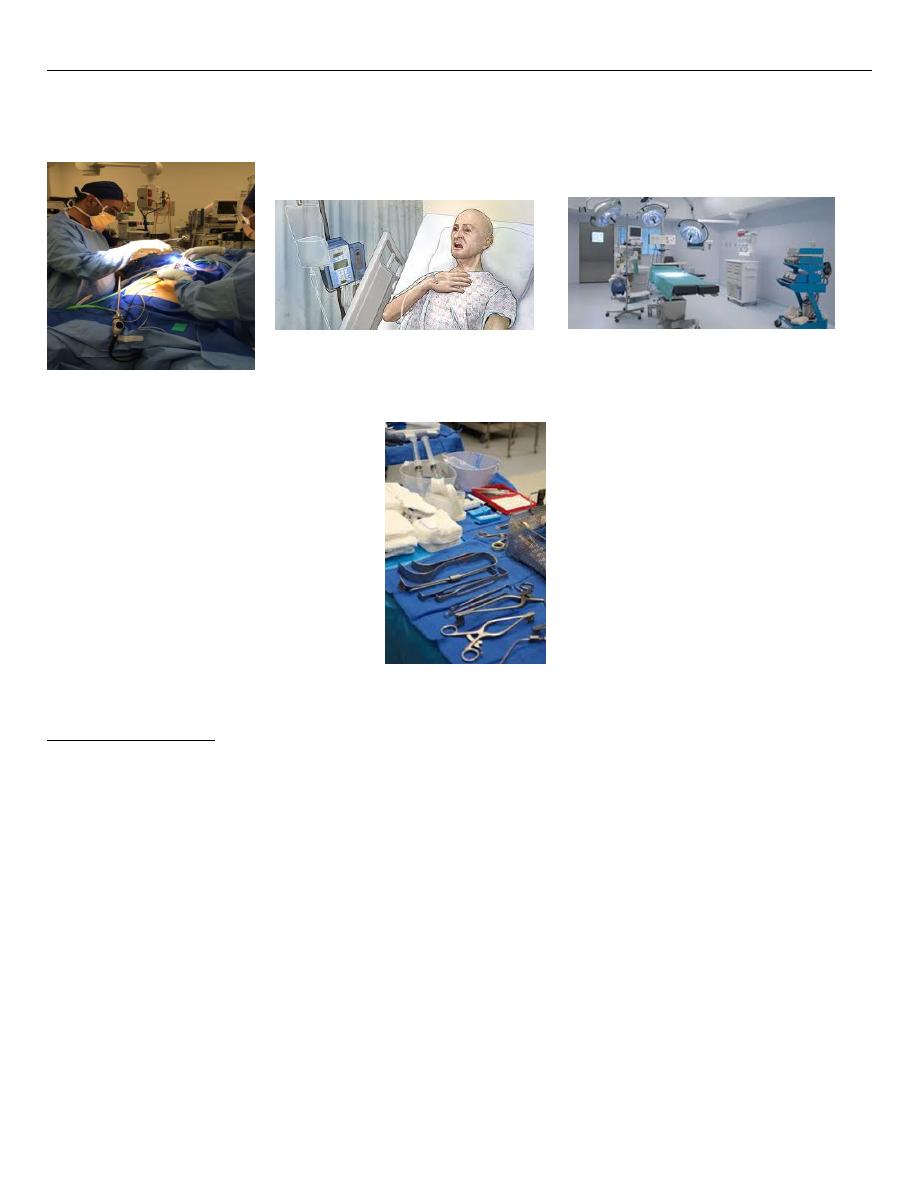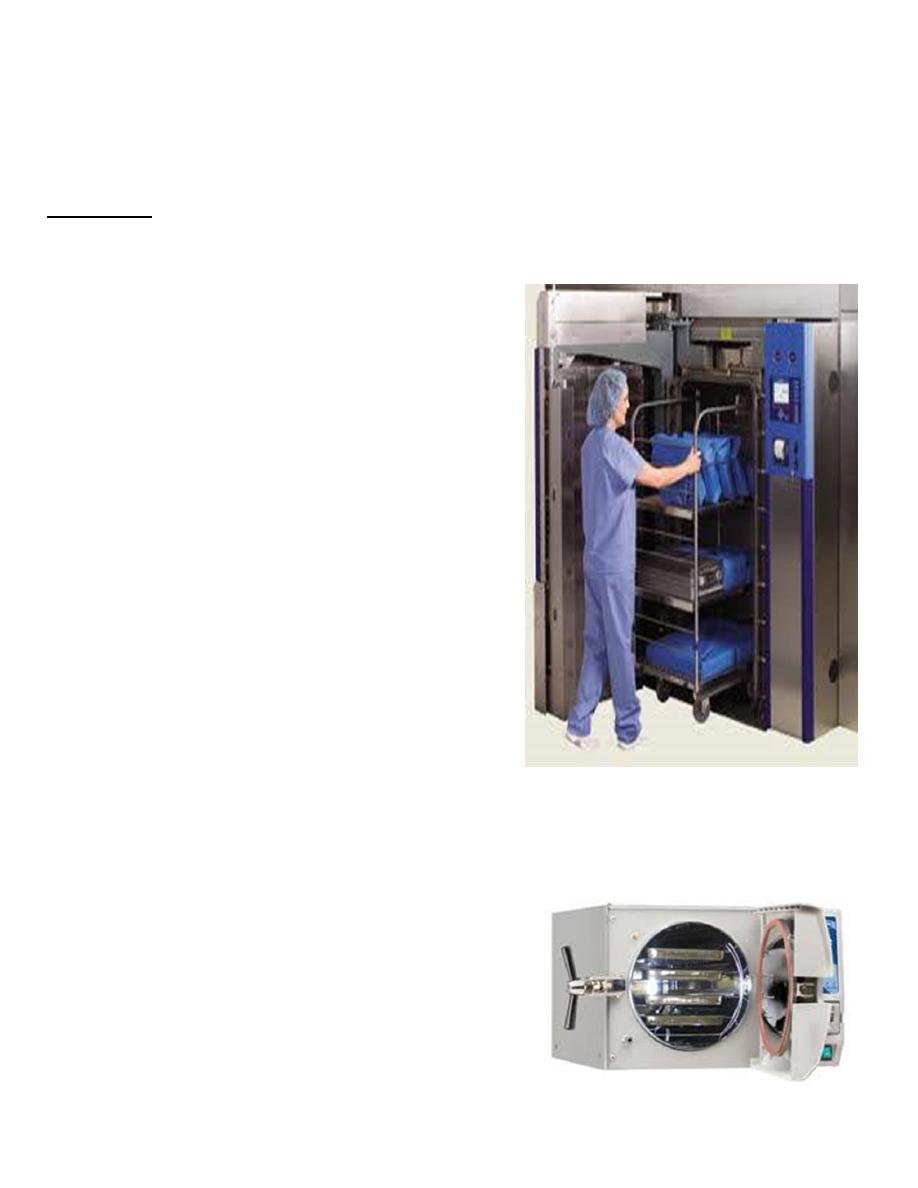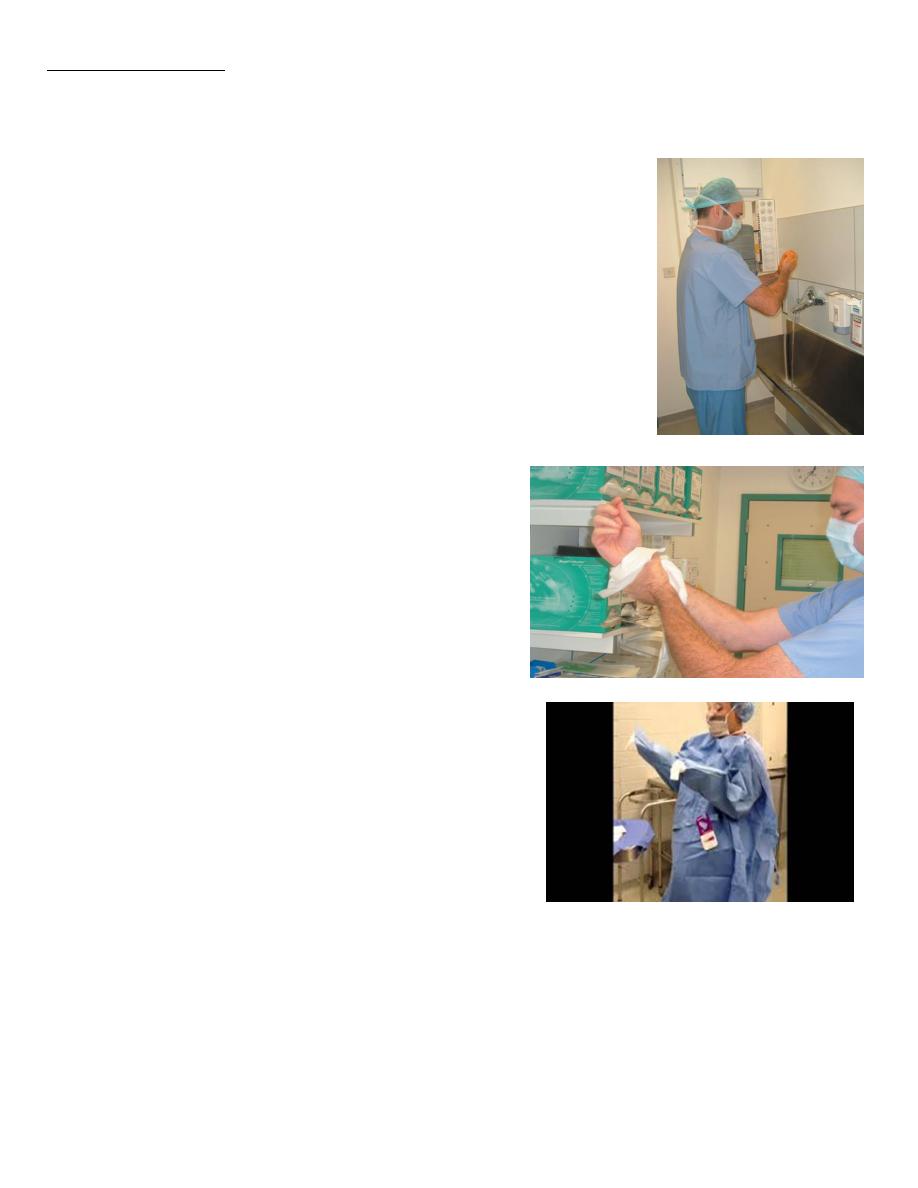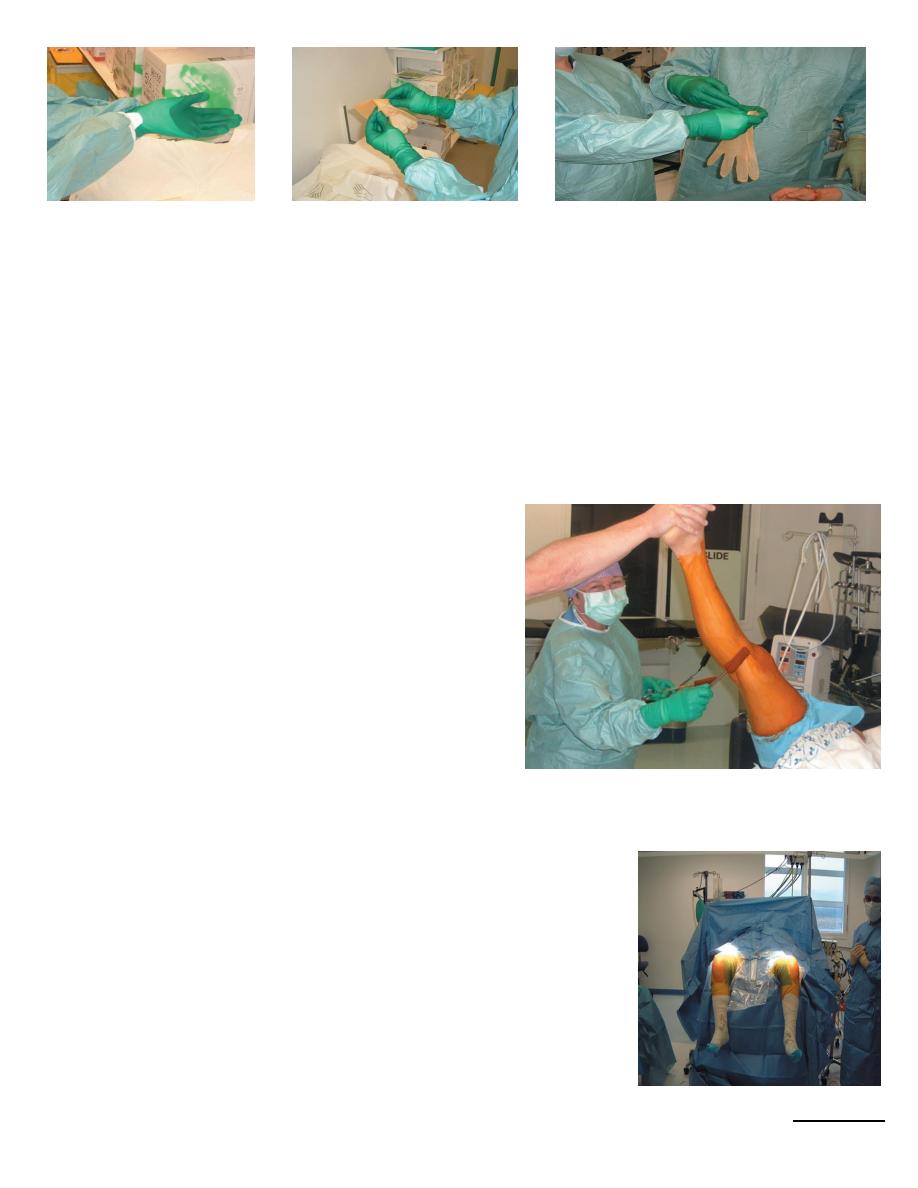
3
rd
Lec. Surgery (Dr. Ali Jaffer) Principles of surgical sterilisation and disinfection
Sources of contamination
Definition of Terms
Sterilization describes a process that destroys or eliminates all forms of microbial life and is carried
out in health-care facilities by physical or chemical methods.
Disinfection describes a process that eliminates many or all pathogenic microorganisms, except
bacterial spores.
Cleaning is the removal of visible soil (e.g., organic and inorganic material) from objects and
surfaces and normally is accomplished manually or mechanically using water with detergents or
enzymatic products. Thorough cleaning is essential before high-level disinfection and sterilization
because inorganic and organic materials that remain on the surfaces of instruments interfere with
the effectiveness of these processes.
Critical items confer a high risk for infection if they are contaminated with any microorganism. This
category includes surgical instruments, cardiac and urinary catheters, implants, and ultrasound
probes used in sterile body cavities.
Surgical personnel
patient
Operating theatre
Surgical equipments

Semicritical items contact mucous membranes or nonintact skin. Ex respiratory therapy and
anesthesia equipment, some endoscopes and others. These medical devices should be free from
all microorganisms; however, small numbers of bacterial spores are permissible.
Noncritical items are those that come in contact with intact skin but not mucous membranes.
Examples of noncritical patient-care items are bedpans, blood pressure cuffs, crutches and
computers.
Factors Affecting the Efficacy of Disinfection and Sterilization
Number and Location of Microorganisms
The larger the number of microbes, the more time a germicide needs to destroy all of them.
Medical instruments with multiple pieces must be disassembled and equipment such as
endoscopes that have crevices, joints, and channels are more difficult to disinfect than are flat-
surface equipment because penetration of the disinfectant of all parts of the equipment is more
difficult.
Innate Resistance of Microorganisms
For example, spores are resistant to disinfectants because the spore coat and cortex act as a
barrier.
Concentration and Potency of Disinfectants
Several physical and chemical factors also influence disinfectant procedures: temperature,
pH, relative humidity, and water hardness.
For example, the activity of most disinfectants increases as the temperature increases, but
some exceptions exist. Furthermore, too great an increase in temperature causes the disinfectant
to degrade and weakens its germicidal activity and thus might produce a potential health hazard.
An increase in pH improves the antimicrobial activity of some disinfectants (e.g.,
glutaraldehyde, quaternary ammonium compounds) but decreases the antimicrobial activity of
others (e.g., phenols, hypochlorites, and iodine).
Relative humidity is the single most important factor influencing the activity of gaseous
disinfectants/sterilants, such as ETO, chlorine dioxide, and formaldehyde.
Organic and Inorganic Matter
Organic matter in the form of serum, blood, pus, or fecal or lubricant material can interfere
with the antimicrobial activity of disinfectants. Most commonly, interference occurs by a chemical
reaction between the germicide and the organic matter resulting in a complex that is less germicidal

or nongermicidal, leaving less of the active germicide available for attacking microorganisms.
Chlorine and iodine disinfectants, in particular, are prone to such interaction
Duration of Exposure
Sterilization
Steam Sterilization
Of all the methods available for sterilization, moist
heat in the form of saturated steam under pressure is
the most widely used and the most dependable.
The two common steam-sterilizing temperatures
are 121°C and 132°C .
Recognized minimum exposure periods for
sterilization of wrapped healthcare supplies are 30
minutes at 121°C (250°F) in a gravity displacement
sterilizer or 4 minutes at 132°C (270°F) in a prevacuum
sterilizer.
The basic principle of steam sterilization, as
accomplished in an autoclave, is to expose each item
to direct steam contact at the required temperature
and pressure for the specified time.
Steam sterilization should be used whenever
possible on all critical and semicritical items that are
heat and moisture resistant.
Flash Sterilization
It is a modification of conventional steam sterilization
in which the flashed item is placed in an open tray or is
placed in a specially designed, covered, rigid container to
allow for rapid penetration of steam.
Adverse events have been associated with flash
sterilization.
Less effective in comparison with steam sterilisation.

It may cause clinical burns so it is need to develop policies and educate staff to prevent the use
of instruments hot enough to cause such injuries.
Ethylene Oxide "Gas" Sterilization
ETO is used in healthcare facilities to sterilize critical items (and sometimes semicritical items) that
are moisture or heat sensitive and cannot be sterilized by steam sterilization.
Ionizing Radiation.
Sterilization by ionizing radiation, primarily by cobalt 60 gamma rays or electron accelerators, is
a low-temperature sterilization method that has been used for a number of medical products (e.g.,
tissue for transplantation, pharmaceuticals, medical devices).
Dry-Heat Sterilizers.
This method should be used only for materials that might be damaged by moist heat or that are
impenetrable to moist heat (e.g., powders, petroleum products, sharp instruments).
Disinfection
• Chlorhexidine gluconate
has a residual effect and is effective for more than 4 hours. It has potent antiseptic activity
against Grampositive and Gram-negative organisms and some viruses but only moderate activity
against the tubercle bacillus.
• Iodine (povidone-iodine)
has some residual effects but these are not sustained for more than 4 hours.
“Free” iodine (I2) contributes to the bactericidal activity of iodophors and dilutions of iodophors
demonstrate more rapid bactericidal action than does a full-strength povidone-iodine solution.
It is highly bactericidal, fungicidal and viricidal. There is some activity against bacterial spores
and good activity against the tubercle bacillus. The iodine agents penetrate cell walls to produce
anti-microbial effects. They may be irritating to the skin or cause allergic reactions.
• The alcohols
are highly effective, rapidly acting anti-microbial agents with broad-spectrum activity. They are
effective in destroying Gram-positive and Gram-negative bacteria, fungi, viruses and tubercle
bacilli, but are not sporicidal. Alcohol is an inexpensive anti-microbial agent and one of the most
widely used skin antiseptics, especially preceding subcutaneous and intramuscular injections and
venepunctures; a 10-s drying after application enhances its effectiveness.

Asepsis at operation
No operating room can be kept completely free of bacteria and, therefore, the risk of a wound
becoming infected from contamination is always present. However, the risk can be minimised by
strict theatre discipline.
Scrubbing is the process of washing the hands and arms prior to
donning a gown and gloves, to minimise the microbial loads on parts
of the surgical staff that might come into contact with the patient.
• Do not scrub if you have an infection
• Make sure all hair is covered and that you are
protected from splashes
• Start scrubbing before, and finish after, the senior
surgeon
• Dry hands from distal to proximal
Gowning
Gloving
They prevent contamination of the surgical wound and they also protect the scrub team from
the blood and body fluids of the patient. Double gloving reduces the chance of a breach in this
protection and allows the outer gloves to be changed if damaged. Double gloving is now a standard
part of ‘universal precautions’ for minimising the transmission of human immunodeficiency virus
(HIV) and hepatitis B and C.

Skin preparation
‘Pre-prep’
• Remove soil and debris.
• Remove of skin hair by clipping.
• For patients undergoing elective surgery, a shower on the day of surgery with a soapy
disinfectant should suffice.
Preparing the patient’s skin (‘prepping’)
■ Performed by staff who are scrubbed up
■ Use aqueous solutions for open wounds, alcohol for
intact skin
■ Work from the incision site outwards
■ Repeat at least twice
■ Clean heavily contaminated areas last and then
discard the prep sponge
■ Remove excessive prep solution with a dry swab
Draping of the operative area
• Surgical draping involves covering with sterile barrier material,
‘drapes’, the area immediately surrounding the operative site.
• Drape materials should resist penetration of microscopic
particles and moisture, limiting the migration of micro-organisms
into the surgical wound.
• The purpose of surgical draping is to create and maintain a
protective zone of asepsis, called a ‘sterile field’.
Thank You
